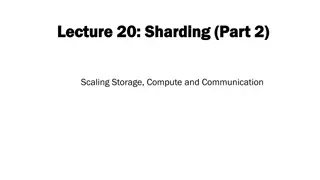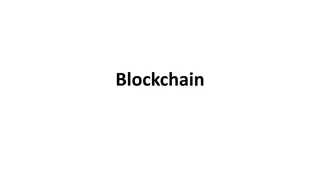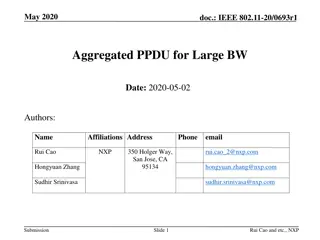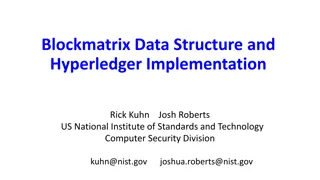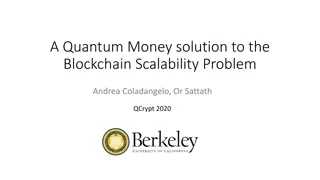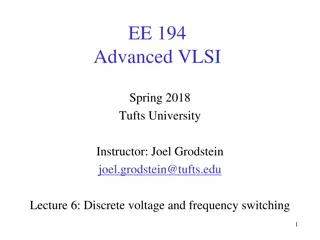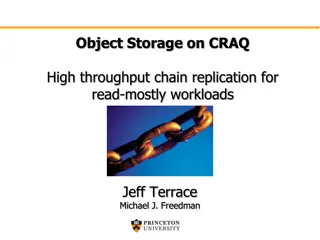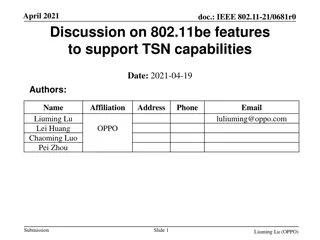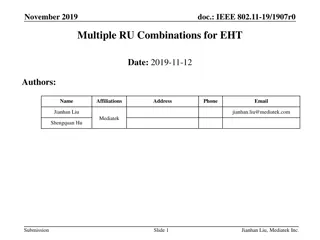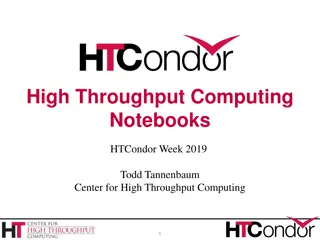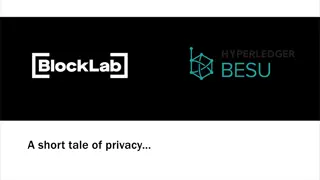Understanding Blockchain Scaling: Throughput Enhancement Strategies
Explore the concept of scaling throughput in blockchain technology through a detailed analysis of Bitcoin and Ethereum performance, limitations in throughput, security implications related to forking, and innovative solutions like GHOST protocol to enhance network efficiency and security.
Uploaded on Sep 14, 2024 | 0 Views
Download Presentation

Please find below an Image/Link to download the presentation.
The content on the website is provided AS IS for your information and personal use only. It may not be sold, licensed, or shared on other websites without obtaining consent from the author. Download presentation by click this link. If you encounter any issues during the download, it is possible that the publisher has removed the file from their server.
E N D
Presentation Transcript
Lecture 8: Scaling Throughput Lecture 8: Scaling Throughput
Four modules Four modules Bitcoin: so far Scaling Bitcoin Improve Bitcoin performance while still retain basic structure of the longest chain protocol Beyond Bitcoin Applications
Performance Performance Throughput: transaction per second ( Throughput: transaction per second (tx tx/s) Bitcoin: 7 Bitcoin: 7 tx tx/s /s Ethereum: 100 Ethereum: 100 tx tx/s /s) /s Why is throughput so small in Bitcoin? Why is throughput so small in Bitcoin?
Throughput Throughput 1 ? ? 1+ 1 ? ?? ? tx/s Throughput = : fraction of adversarial hash power; no control ?: mining rate; can be controlled by setting mining target easy ?: block size; can be controlled by allowing more transaction in a block : network delay; proportional to block size ? 1 ? ? 1+ 1 ? ??, limited by ? So throughput
Recap: security Recap: security Security holds when longest chain mining growth rate > adversarial private chain growth rate, i.e., 1 ? ? 1 + 1 ? ??> ?? So throughput is limited due to forking (and security)
Scaling throughput Scaling throughput In this lecture, we study 3 efforts to improve throughput The first two are flawed to different levels And the third solves the problem, where only the network limits the throughput
Idea 1: embrace forking Idea 1: embrace forking GHOST: Greedy Heaviest-Observed Sub-Tree A modification to the mining rule: no longer mine on the tip of the longest chain; mine on the tip of the GHOST chain 12 11 1 5 4 1 2 1 3 2 1 1 GHOST chain 1 Longest Chain
Private attack on GHOST Private attack on GHOST The GHOST chain is harder to displace by a private attack Because all the blocks in the sub-tree count; so forking is not wasted Hence the mining rate can be increased without worrying about forking 9 10 11 12 13 Private blocks 8 1 2 3 4 1 4 2 1 2 3 1 1 1 2 1 1 1 GHOST Chain Longest chain
GHOST is secure? GHOST is secure? The logic behind GHOST refers to resistance to the private attack We already know that the private attack was the worst case attack for the longest chain protocol the longest chain protocol However, the worst case attack for GHOST could be different However, the worst case attack for GHOST could be different
Balance attack on GHOST Balance attack on GHOST The idea is to have two chains and honest mining is split between them The adversary reveals private blocks to keep the weights of two sub- trees equal. Private block for balance attack 21 22 23 24 10 11 10 11 12 1 1 1 1 5 3 5 4 2 1 1 2 1 1 2 3 1 1 1 2 Tips Tips 1 GHOST chain 2 GHOST Chain1
Balance attack on GHOST Balance attack on GHOST The idea is to have two chains and honest mining is split between them The adversary reveals private blocks to keep the weights of two sub- trees equal. Balance attack is a bit more subtle than private attack in the sense that more network control is needed Safety attack: Safety attack: because the ledger swings wildly between two sub-trees
Idea2: reduce forking Idea2: reduce forking Longest chain rule: miner proposes only one block for a successful nonce Idea: why not do many blocks for one mining? How is this different from a large block size?
Bitcoin Bitcoin- -NG NG Consist of proposer blocks and transaction blocks Only mine the proposer block at the tip of the longest chain The same proposer signs transaction blocks
Bitcoin Bitcoin- -NG NG K-deep rule: PoW blocks PoW difficulty level same as Bitcoin: same security Tx blocks contain payload; generation rate is not limited by PoW (security) Ledger creation: pull in all Tx blocks into parent PoW block
Bitcoin Bitcoin- -NG NG Positive: Throughput is high because Tx blocks are many in number and only limited by network capacity Negative: Bitcoin-NG is permissionless but does not have all security of longest chain protocol Predictability Predictability
Bribing attack on Bribing attack on Bitcoin Bitcoin- -NG NG On longest chain protocol: a) There is unpredictability on who successfully mines b) After mining, the block is sealed by the nonce and cannot be altered Putting a) & b), Bitcoin is very resistant to bribing attacks But in Bitcoin-NG, a) & b) are true only for PoW blocks, but not true for Tx blocks
Bribing attack on Bribing attack on Bitcoin Bitcoin- -NG NG But in Bitcoin-NG, a) & b) are true only for PoW blocks, but not true for Tx blocks So Tx blocks are vulnerable to bribing attacks Corrupt
Idea 3: Prism 1.0 Idea 3: Prism 1.0 Bitcoin-NG is a good idea: it separated security form payload/data Prism 1.0 is similar to Bitcoin-NG Consist of proposer blocks and transaction blocks But Transaction blocks are not linked but referred by proposer blocks The PoW for transaction blocks is easy for throughput The PoW for proposer blocks is hard for security


